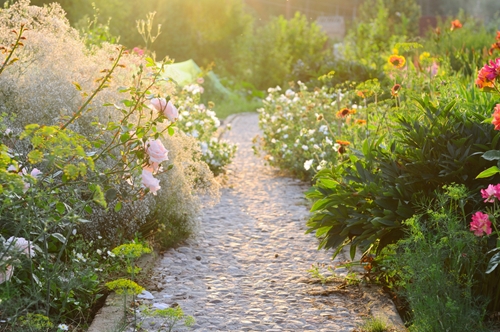
If you want your home to be picture perfect, then you should think of landscaping as the frame. The right exterior design not only showcases your home, it also has the ability to put it in the best possible light. Also like a picture frame, landscaping can cost quite a bit more money than you'd originally intended to spend.
Designing outdoor terrain wisely and economically is in many ways a unique response to lots and the floor plans involved. After all, you would never want to block an interesting detail lifted from modern house plans with shrubs, nor would you want to leave a two-story house's yard bare, making it feel exposed and imposing. Fortunately, there are plenty of ways to save money while still creating beautiful yards. To better illustrate smart design, here are some tips and how they would apply to one of our contemporary house plans were it built in the New England area.
Account for site
This particular plan is designed for a sloped lot, so that the front facade appears only to be one story, while the backyard reveals a sprawling first floor, a sizable basement and an interestingly asymmetrical design. Given the cutaway nature of the home, there is plenty of opportunity for landscaping all around the house.
Homeowners may be tempted to blindly landscape their yard with all of the plants and trees they love, but that can end up with a large bill for unnecessary design. Landscaping should be a response to the house's focal points and design elements. As such, trees in the front yard would unnecessarily obscure the grand pillared entrance and the interesting stone wall facade. Low shrubs may be a better choice. As you walk along the left side of the house, you can start to incorporate taller bushes and trees as the wall gets larger. Flowers can also be used strategically to emphasize walking paths, creating a strong visual element that doesn't require an entire flower bed. By choosing plants as a tool for showcasing your house, you can save more money than by just designing a pretty yard.
Buy natives and perennials
The kinds of flowers and shrubs you choose to buy will likely be the largest factor in your landscaping expense. Exotic flowers and shrubs that can't handle the climate are ultimately a waste of money. Stick to tried and true plants that will thrive in the region. Better Homes and Gardens provides a guide to the top native plants of the Northeast, many of which are easy to grow and maintain. Wild Anemone and Merrybells, for example, are both beautiful ground covers that can be used to line the sides of the house or demarcate the border of your property.
Also, you'll get more bang for your buck with perennials. They last longer than other types of plants and also generally cost less. Be sure to accent with at least some kind of tree, which can become an essential focal point on the back end of a house as sizable as our example.
Utilize mulch paths and built objects
This home boasts plenty of nooks and crannies. Laying down winding flagstone paths can be expensive and unnecessary, especially for a home that lends itself to a more humble landscaping approach. Mulch paths are cheaper than stone and match the country cottage vibe of the front-yard design.
Buy and plant at the right time
Plants and seeds change in cost throughout the year depending on the season and kind of plant. Research the cheapest seasons for those plants that interest you before buying. Also, you should plant at those times that best guarantee survival. Summer can leave flowers and grass without water to establish roots. In New England, you should also be wary of fluctuating temperatures in early spring that might frost and kill plants.